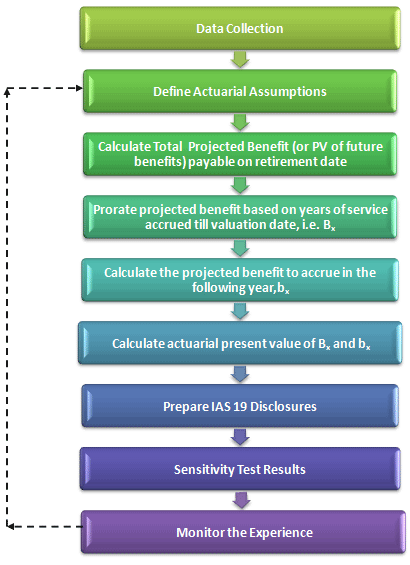The flowchart below gives a pictorial view of the employee defined benefits (e.g. gratuity, pension) actuarial valuation process:
Step 1: Data Collection (e.g. employee data such as dates of birth and employment, salary, etc.; plan details; fund asset details; prior valuation reports and IAS disclosures; fund accounts including details of the fair value of plan assets at the beginning of period, actual return on plan assets, employer’s contributions made during the period, benefits and expenses paid during the period, expected rate of return on plan assets).
Step 2: Determine actuarial assumptions for the discount rate, future salary and benefit (e.g. pension indexation) growth rate, employee turnover or withdrawal rate, pre- and post- retirement mortality rate, employee disability rate, employee early retirement rate, proportion of plan members with dependants who will be eligible for benefits, expected return on plan assets, claim rates under medical plans and future medical costs.
Step 3: Calculate the total projected benefit payable on the retirement date, Br.
Under a gratuity plan, this is a lump sum payment to be made on the date of retirement based usually on a projected final salary.
Under a pension plan, this is the actuarial present value of all future pension payments that will be made from the date of retirement onwards until the death of the employee or death of his dependants depending on the plan benefits defined. These future pension benefits are discounted to the retirement date for post-retirement mortality and interest.
Under a post employment plan that pays for the medical cost, this is the actuarial present value of all future medical costs discounted for post-retirement mortality, claim rates on medical plans and interest.
For calculating the actuarial present value, under deterministic assumptions for decrements and interest, commutation functions may be employed.
Step 4: Under IAS 19 the actuarial valuation method is the Projected Unit Credit (PUC) method. Prorate the projected benefit for each year of service accrued till the valuation date, i.e. Bx= Br*(x-e)/(r-e). Note that here we are assuming that the benefit accrual unit is the same for each year of service.
Step 5: Determine the retirement/ post-retirement benefit to be accrued for the following year, i.e. bx= Br/(r-e). Note that here we are assuming that the benefit accrual unit is the same for each year of service.
Step 6: Discount Bx and bx for decrements (pre-retirement mortality, early retirement, disability, turnover, etc.) and interest to the valuation date to determine the Actuarial Liability for the year and the Normal or Current Service Cost for the following year.
For discounting the retirement/ post-retirement benefit to the valuation date, under deterministic assumptions for decrements and interest, commutation functions may be employed.
A simple example for valuing a gratuity benefit payable to an individual employee is given in the following post:
Gratuity Valuation – A Simple Example
Step 7: Prepare IAS 19 Disclosures Gratuity Valuation: IAS 19 Disclosures: Simple Example Continued
Step 8: Sensitivity test results for changes to key assumptions and identify key risks. Gratuity Valuation – A Simple Example Continued – Sensitivity Analysis
Step 9: Carry out an actuarial gain and loss analysis. Monitor expected decrements against actual numbers (i.e. develop the number of participants over the valuation year indicating those entering and exiting the plan including the reasons for exit) and monitor expected interest cost and return against those actually realized to ensure that actuarial assumptions are still valid and effective and to account for actual experience and sources of actuarial gain and loss.

